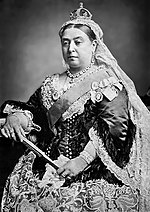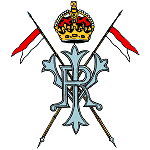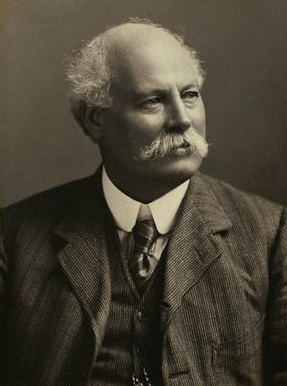This article needs additional citations for verification .(March 2014) |
| |||||
| Centuries: | |||||
|---|---|---|---|---|---|
| Decades: | |||||
| See also: | List of years in India Timeline of Indian history | ||||
Events in the year 1877 in India.
This article needs additional citations for verification .(March 2014) |
| |||||
| Centuries: | |||||
|---|---|---|---|---|---|
| Decades: | |||||
| See also: | List of years in India Timeline of Indian history | ||||
Events in the year 1877 in India.


Emperor or Empress of India was a title used by British monarchs from 1 May 1876 to 22 June 1948 to signify their sovereignty over the Indian Empire as its imperial head of state. The image of the emperor or empress appeared on Indian currency, in government buildings, railway stations, courts, on statues etc. Oaths of allegiance were made to the emperor or empress and the lawful successors by the governors-general, princes, governors, commissioners in India in events such as imperial durbars.

The governor-general of India was the representative of the monarch of the United Kingdom in their capacity as the Emperor/Empress of India and after Indian independence in 1947, the representative of the Monarch of India. The office was created in 1773, with the title of Governor-General of the Presidency of Fort William. The officer had direct control only over his presidency but supervised other East India Company officials in India. Complete authority over all of British territory in the Indian subcontinent was granted in 1833, and the official came to be known as the "Governor-General of India".

Edward Robert Lytton Bulwer-Lytton, 1st Earl of Lytton,, was an English statesman, Conservative politician and poet who used the pseudonym Owen Meredith. During his tenure as Viceroy of India between 1876 and 1880, Queen Victoria was proclaimed Empress of India. He served as British Ambassador to France from 1887 to 1891.

General Sir Samuel James Browne, was a British Indian Army cavalry officer, known best as the creator of the Sam Browne belt. He was a recipient of the Victoria Cross, the most prestigious award for gallantry in combat that can be awarded to British and Commonwealth forces.

The Delhi Durbar was an Indian imperial-style mass assembly organized by the British at Coronation Park, Delhi, India, to mark the succession of an Emperor or Empress of India. Also known as the Imperial Durbar, it was held three times, in 1877, 1903, and 1911, at the height of the British Empire. The 1911 Durbar was the only one that a sovereign, George V, attended. The term was derived from the common Persian term durbar.

The Royal Titles Act 1876 was an act of the Parliament of the United Kingdom which officially recognized Queen Victoria as "Empress of India".

The 21st Lancers (Empress of India's) was a cavalry regiment of the British Army, raised in 1858 and amalgamated with the 17th Lancers in 1922 to form the 17th/21st Lancers. Perhaps its most famous engagement was the Battle of Omdurman, where Winston Churchill (then an officer of the 4th Hussars), rode with the unit.
Events in the year 1875 in India.

John Lockwood Kipling was an English art teacher, illustrator and museum curator who spent most of his career in India. He was the father of the author Rudyard Kipling.

Sir Thomas Brock was an English sculptor and medallist, notable for the creation of several large public sculptures and monuments in Britain and abroad in the late nineteenth and early twentieth centuries. His most famous work is the Victoria Memorial in front of Buckingham Palace, London. Other commissions included the redesign of the effigy of Queen Victoria on British coinage, the massive bronze equestrian statue of Edward, the Black Prince, in City Square, Leeds and the completion of the statue of Prince Albert on the Albert Memorial.

Coronation Park is a park located at Burari Road near Nirankari Sarovar in Delhi, India. It was the venue of the Delhi Durbar of 1877 when Queen Victoria was proclaimed the Empress of India. Later it was used to celebrate the accession of King Edward VII in 1903, and, finally, it was here that the Durbar commemorating the coronation of King George V as Emperor of India took place on 12 December 1911, subsequent to his coronation at Westminster Abbey in June 1911. This last celebration had all the princely states in attendance. The decision to hold the Coronation Durbars in Delhi at the vast open ground at Coronation Park was a move to emphasise the historical significance of Delhi as the former capital of the Mughal Empire.
Events from the year 1876 in the United Kingdom.

Maharajadhiraj Mirza Maharao Sir Khengarji III Sawai Bahadur was a progressive and one of the longest ruling monarchs and also the longest ruling king of the Princely State of Kutch from 1875 to 1942.
Events in the year 1876 in India.
Events in the year 1878 in India.
Events in the year 1880 in India.
Events in the year 1879 in India.

Edith Bulwer-Lytton, Countess of Lytton, was a British aristocrat. As the wife of Robert Bulwer-Lytton, 1st Earl of Lytton, she was vicereine of India. After his death, she was a court-attendant of Queen Victoria. Her children included suffragette Constance Bulwer-Lytton.

The Statue of Queen Victoria, Bangalore, is located at Queen's Park, next to Cubbon Park, Bangalore Cantonment, at the junction of 3 roads, at the border between the Cantonment and the Bangalore Pete. The statue was unveiled on 5 February 1906 by the then Prince of Wales, George Frederick Ernest Albert. The statue was raised out of funds raised by the residents of the Bangalore Civil and Military Station and contributions made by Krishna Raja Wadiyar IV, the Maharaja of Mysore. This Statue of Queen Victoria is one of the five of the original 50 statues of Queen Victoria which were installed in British India, to still stand at its original location. The statue has blossoms of jacaranda falling around. On the other end of Queen's Park is the Statue of King Edward VII.
The Hindu Sena, is an Indian right-wing Hindu nationalist organization, founded on 10 August 2011 by Vishnu Gupta, who is also its current leader.